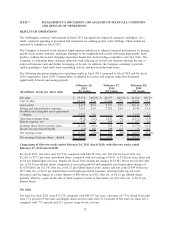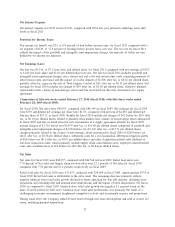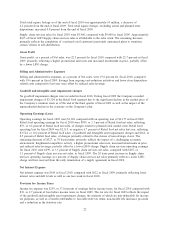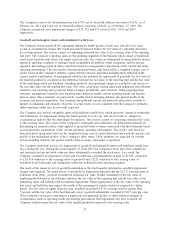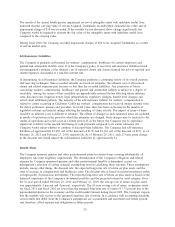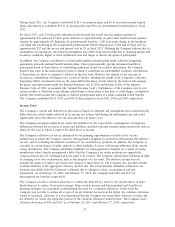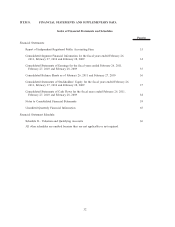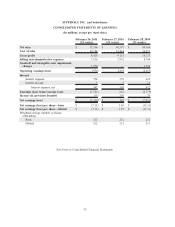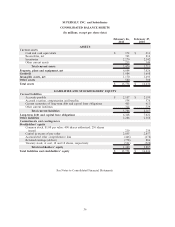Albertsons 2011 Annual Report Download - page 30
Download and view the complete annual report
Please find page 30 of the 2011 Albertsons annual report below. You can navigate through the pages in the report by either clicking on the pages listed below, or by using the keyword search tool below to find specific information within the annual report.The results of the annual fourth quarter impairment review of intangible assets with indefinite useful lives
indicated that the carrying value of certain Acquired Trademarks exceeded their estimated fair value and an
impairment charge of $30 was recorded. If the variable factors discussed above change significantly, the
Company would be required to reassess the fair value of the intangible assets with indefinite useful lives
compared to the carrying value.
During fiscal 2010, the Company recorded impairment charges of $20 to its Acquired Trademarks as a result
of certain market exits.
Self-Insurance Liabilities
The Company is primarily self-insured for workers’ compensation, healthcare for certain employees and
general and automobile liability costs. It is the Company’s policy to record its self-insurance liabilities based
on management’s estimate of the ultimate cost of reported claims and claims incurred but not yet reported and
related expenses, discounted at a risk-free interest rate.
In determining its self-insurance liabilities, the Company performs a continuing review of its overall position
and reserving techniques. Since recorded amounts are based on estimates, the ultimate cost of all incurred
claims and related expenses may be more or less than the recorded liabilities. Any projection of losses
concerning workers’ compensation, healthcare and general and automobile liability is subject to a degree of
variability. Among the causes of this variability are unpredictable external factors affecting future inflation
rates, discount rates, litigation trends, legal interpretations, regulatory changes, benefit level changes and
actual claim settlement patterns. The majority of the self-insurance liability for workers’ compensation is
related to claims occurring in California. California workers’ compensation has received intense scrutiny from
the state’s politicians, insurers and providers. In recent years, there has been an increase in the number of
legislative reforms and judicial rulings affecting the handling of claim activity. The impact of many of these
variables on ultimate costs is difficult to estimate. The effects of changes in such estimated items are included
in results of operations in the period in which the estimates are changed. Such changes may be material to the
results of operations and could occur in a future period. If, in the future, the Company was to experience
significant volatility in the amount and timing of cash payments compared to its earlier estimates, the
Company would assess whether to continue to discount these liabilities. The Company had self-insurance
liabilities of approximately $1,050, net of the discount of $178, and $1,101, net of the discount of $191, as of
February 26, 2011 and February 27, 2010, respectively. As of February 26, 2011, each 25 basis point change
in the discount rate would impact the self-insurance liabilities by approximately $1.
Benefit Plans
The Company sponsors pension and other postretirement plans in various forms covering substantially all
employees who meet eligibility requirements. The determination of the Company’s obligation and related
expense for Company-sponsored pension and other postretirement benefits is dependent, in part, on
management’s selection of certain actuarial assumptions used in calculating these amounts. These assumptions
include, among other things, the discount rate, the expected long-term rate of return on plan assets and the
rates of increase in compensation and healthcare costs. The discount rate is based on current investment yields
on high-quality fixed-income investments. The expected long-term rate of return on plan assets is based on the
historical experience of the Company’s investment portfolio and the projected returns by asset category. Over
the 10-year period ended February 26, 2011 and February 27, 2010, the average rate of return on plan assets
was approximately 5 percent and 4 percent, respectively. The 10-year average rate of return on pension assets
for fiscal 2011 and fiscal 2010 are lower than the assumed long-term rate of return of 7.75 percent due to the
unprecedented decline in the economy and the credit market turmoil during fiscal 2009. The Company expects
that the markets will recover to the assumed long-term rate of return. In accordance with accounting standards,
actual results that differ from the Company’s assumptions are accumulated and amortized over future periods
and, therefore, affect expense and obligations in future periods.
26





